
|
||
|
Portland art blog + news + exhibition reviews + galleries + contemporary northwest art
|
||
Kazumi Murose at Portland Japanese Garden 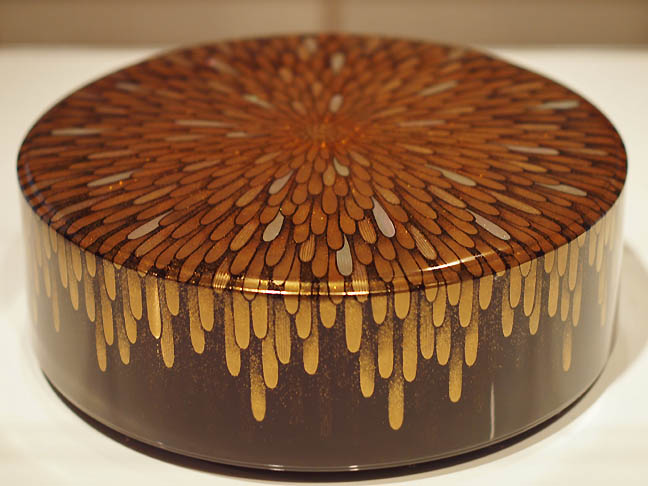 Kuzumi Murose "Hyakka" (one hundred flowers), 2012 (all photos Jeff Jahn) It is your last weekend to catch it but Urushi: Masterpieces of Lacquerware featuring the work of Kazumi Murose is an exceptional reason to visit Portland's stunning Japanese Garden. The ice from the cold with the Fall colors are also auspiciously in full effect. Lacquer is an ancient and painstaking way to create incredibly strong yet delicate objects from the resin sap of sumac trees and Portland is lucky to have Kazumi Murose, a National Living Treasure of Japan. That designation is given to fifty craftpersons working in a medium with an ancient tradition in Japan, but rather than an exercise in anachronism Murose considers "tradition" as something to "continually create" and is noted for his innovations in Maki-e (sprinkled gold and silver decoration) as well as Raden (inlays utilizing turbo shell). In particular his gold Maki-e technique creates atmospheric effects not unlike when a golden sunbeam cuts though the crack of a door illuminating flecks of dust as the sun rises or sets. It has spatial dimensionality different than earlier forms of lacquer. 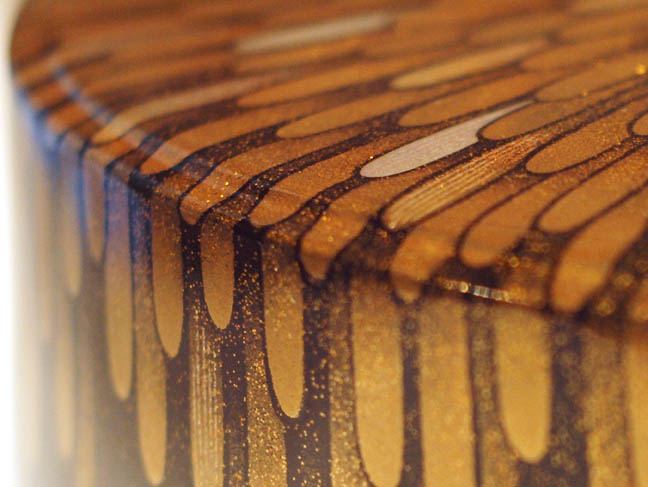 (detail side) "Hyakka" (one hundred flowers), 2012 You can see this ephemeral effect very clearly in a medium sized round box called "Hyakka" (one hundred flowers). Notice the gradients of gold dust, these are built up and very difficult to develop a sense of smoothly changing densities. Overall, the multi-layered cascade of petals alternating the Maki-e and the iridescent Raden shell inlay is truly fantastic and it makes me consider the particular gift or Omiyage and corresponding O-kaeshi (the thank you gift) aspect of the culture. Surely, a culture that where etiquette widely incorporates gift giving for auspicious occasions would bring heightened awareness of the box and sustain a developing tradition like lacquerware. In the USA the box is nearly never this considered. 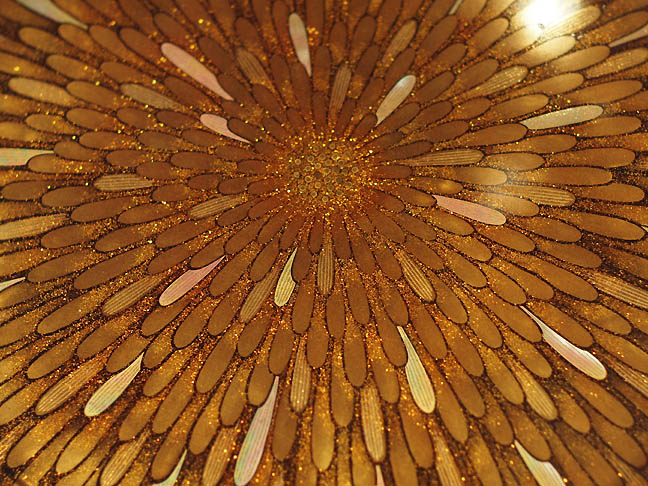 (detail top) "Hyakka" (one hundred flowers), 2012 Also, on this piece the Raden made petals have fine striations in them made by hand cracking the shell rather than gold lines showing how each visual manifestation has an aspect of physical manifestation rather than just being a pictorial device. Thus, this item though empty is full of wondrous experience. It isn't unlike light and space art and I wonder what someone like Robert Irwin would think of these objects, which are more presences through virtue of their extreme craft than simply objects. 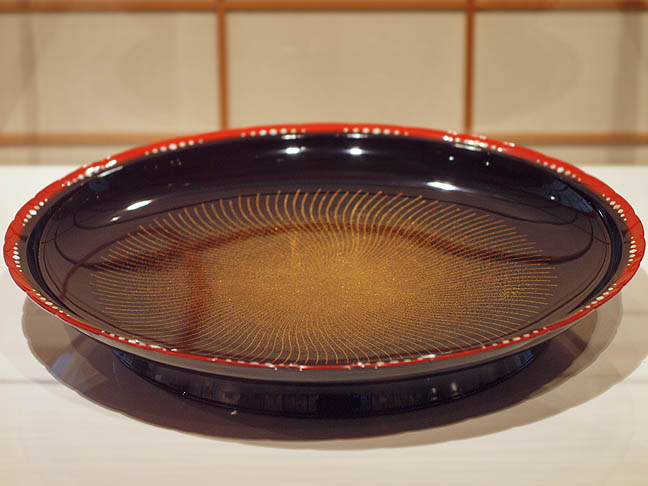 "Shuko" (Vermillion), 2005 Another favorite is a large plate like vessel "Shuko" (Vermillion) it has a swirling design made using Maki-e in the center that has to be seen to be experienced. I like the way these craft objects are so highly considered in Japan and it stands in stark difference to the US, whose import customs don't recognize utilitarian objects as fine art as a legal classification. Any curator who has dealt with customs (US or any other country) can see the problem with such differentiations can make (you think bowls are difficult try taxidermy or food). It is why I don't see the whole "Craft is a verb" as sophisticated enough. Instead craft is an existential commitment and is present in all things to varying degrees, developing a certain connoisseurship in the wake of their intentionally fine existence. In Kazumi Murose's case he chose to follow in his Father's trade in the middle of the 20th Century when such a thing was against the grain and the overall level of achievement here elevates the work. Thus, anyone marginally observant in say 1-200 years would have to note the care and rigor with which these inherently fine objects are constructed. I consider this a conceptual intent, with an experience as the outcome. The exhibition is filled with other objects like pendants, cups and tea caddies and even a harp, all whose existential presence are imbued with Japanese culture, fulfilling the Living National Treasure designation. In the US we have National Parks and it would be interesting to see if we could treat traditions in a similar way. I don't think it is likely. 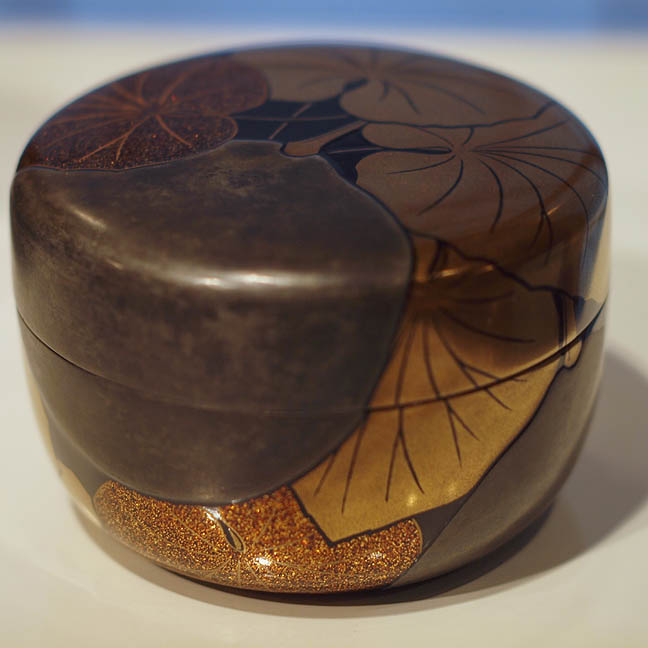 Tea Caddy with Moonflower Design, 2014 One object, a Tea Caddy with Moonflower helps underscore the enjoyment of observation this exhibition brings. Upon the surface Murose has included a hammered pewter element which seems to celebrate wabi sabi style imperfections. This is very interesting to contemplate and as a tea caddy seems especially appropriate in its unusualness. Urushi: Masterpieces of Lacquerware lives up to its name, and being filled with objects invested with practical purposes does nothing to blunt their existential qualities and impact. If anything I wish these exhibits were up much longer but perhaps it only helps underscore why the garden is expanding with a design by architect Kengo Kuma. This exhibition is excellent and should not be missed. Urushi: Masterpieces of Lacquerware | Through November 16th, 2014 Posted by Jeff Jahn on November 15, 2014 at 14:46 | Comments (0) Comments Post a comment Thanks for signing in, . Now you can comment. (sign out)
(If you haven't left a comment here before, you may need to be approved by
the site owner before your comment will appear. Until then, it won't appear
on the entry. Thanks for waiting.)
|
| s p o n s o r s |
 |
 |
 |
 |
 |
 |
 |
 |
 |
 |
 |
 |
 |
 |
 |
 |

|
Site Design: Jennifer Armbrust | • | Site Development: Philippe Blanc & Katherine Bovee | |

